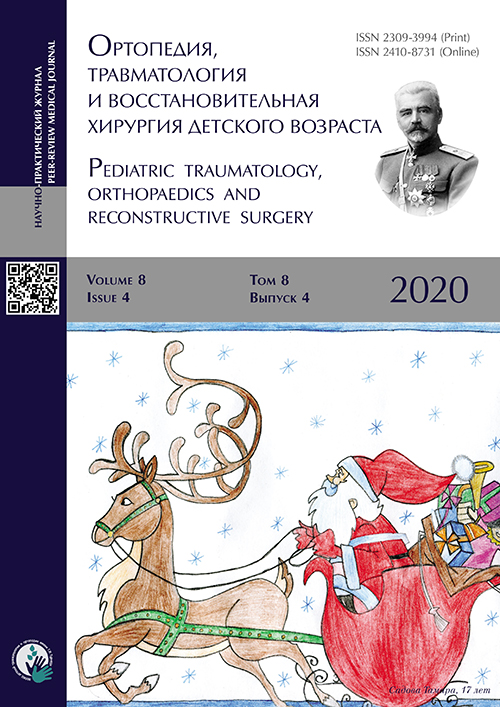Клинико-генетические характеристики и ортопедические проявления синдрома Саула – Вильсона у двух российских больных
- Авторы: Маркова Т.В.1, Кенис В.М.2, Мельченко Е.В.3, Демина Н.А.1, Гундорова П.1, Нагорнова Т.С.1, Дадали Е.Л.1
-
Учреждения:
- Федеральное государственное бюджетное научное учреждение «Медико-генетический научный центр имени академика Н.П. Бочкова» Министерства образования науки Российской Федерации
- Федеральное государственное бюджетное учреждение «Национальный медицинский исследовательский центр детской травматологии и ортопедии имени Г.И. Турнера» Министерства здравоохранения Российской Федерации
- Федеральное государственное бюджетное учреждение «Национальный медицинский исследовательский центр детской травматологии и ортопедии имени Г.И. Турнера» Министерства здравоохранения Российской Федерации
- Выпуск: Том 8, № 4 (2020)
- Страницы: 451-460
- Раздел: Клинические случаи
- Статья получена: 21.04.2020
- Статья одобрена: 15.07.2020
- Статья опубликована: 09.01.2021
- URL: https://journals.eco-vector.com/turner/article/view/33826
- DOI: https://doi.org/10.17816/PTORS33826
- ID: 33826
Цитировать
Аннотация
Обоснование. Синдром Саула – Вильсона (микроцефальная остеодиспластическая дисплазия) — редкий генетический вариант скелетных дисплазий, отнесенный в соответствии с современной классификацией к группе дисплазий тонких костей. К настоящему времени описано 16 больных из разных стран с синдромом Саула – Вильсона, обусловленным нуклеотидной заменой гуанина на цитозин или аденин в положении 1546 в гене COG4, приводящей к замене глицина на аргинин в положении 516 белковой молекулы. Наиболее ярко данный синдром проявляется со стороны опорно-двигательного аппарата.
Клинические наблюдения. Представлено первое описание клинико-генетических характеристик двух российских больных с синдромом Саула – Вильсона и проведено сопоставление с литературными данными. Установлено, что основные клинические проявления заболевания характеризуются сочетанием нанизма, патологии длинных трубчатых костей, позвоночника и органа зрения. Проанализирована динамика формирования фенотипа больных в различные возрастные периоды.
Обсуждение. Анализ особенностей клинических проявлений наблюдаемых нами больных и пациентов, описанных в литературе, показал типичные дизморфические черты строения лица и рентгенологические данные, позволяющие заподозрить синдром Саула – Вильсона при клиническом осмотре. Как и у большинства описанных больных, мажорной мутацией в гене, ответственном за возникновение заболевания, является нуклеотидная замена c.1546G>A, приводящая к замене аминокислоты Gly516Arg в белковой молекуле.
Заключение. На основании выявленных специфических особенностей фенотипа пациентов с синдромом Саула – Вильсона и наличия мажорной мутации в гене COG4, ответственном за его возникновение, высказано предложение о первоочередном анализе мутаций в гене при проведении молекулярно-генетической диагностики синдрома. Ортопедические проявления синдрома могут приводить как к жизнеугрожающим состояниям (нестабильность шейного отдела позвоночника), так и к двигательным ограничениям (прогрессирующий коксартроз), поэтому пациентов необходимо наблюдать в динамике.
Ключевые слова
Полный текст
Об авторах
Татьяна Владимировна Маркова
Федеральное государственное бюджетное научное учреждение «Медико-генетический научный центр имени академика Н.П. Бочкова» Министерства образования науки Российской Федерации
Автор, ответственный за переписку.
Email: markova@med-gen.ru
ORCID iD: 0000-0002-2672-6294
канд. мед. наук, врач-генетик консультативного отделения
Россия, МоскваВладимир Маркович Кенис
Федеральное государственное бюджетное учреждение «Национальный медицинский исследовательский центр детской травматологии и ортопедии имени Г.И. Турнера» Министерства здравоохранения Российской Федерации
Email: kenis@mail.ru
ORCID iD: 0000-0002-7651-8485
SPIN-код: 5597-8832
Scopus Author ID: 341189
http://www.rosturner.ru/kl4.htm
д-р мед. наук, заместитель директора по развитию и внешним связям, руководитель отделения патологии стопы, нейроортопедии и системных заболеваний
Россия, Санкт-ПетербургЕвгений Викторович Мельченко
Федеральное государственное бюджетное учреждение «Национальный медицинский исследовательскийцентр детской травматологии и ортопедии имени Г.И. Турнера» Министерства здравоохранения Российской Федерации
Email: emelchenko@gmail.com
канд. мед. наук, врач — травматолог-ортопед, научный сотрудник отделения патологии стопы, нейроортопедии и системных заболеваний
Россия, Санкт-ПетербургНина Александровна Демина
Федеральное государственное бюджетное научное учреждение «Медико-генетический научный центр имени академика Н.П. Бочкова» Министерства образования науки Российской Федерации
Email: ndemina47@mail.ru
ORCID iD: 0000-0003-0724-9004
врач-генетик, заслуженный врач РФ
Россия, МоскваПолина Гундорова
Федеральное государственное бюджетное научное учреждение «Медико-генетический научный центр имени академика Н.П. Бочкова» Министерства образования науки Российской Федерации
Email: markova@med-gen.ru
ORCID iD: 0000-0001-8703-7997
канд. биол. наук, старший научный сотрудник лаборатории ДНК-диагностики
Россия, МоскваТатьяна Сергеевна Нагорнова
Федеральное государственное бюджетное научное учреждение «Медико-генетический научный центр имени академика Н.П. Бочкова» Министерства образования науки Российской Федерации
Email: t.korotkaya90@gmail.com
ORCID iD: 0000-0003-4527-4518
врач лабораторной генетики лаборатории селективного скрининга
Россия, МоскваЕлена Леонидовна Дадали
Федеральное государственное бюджетное научное учреждение «Медико-генетический научный центр имени академика Н.П. Бочкова» Министерства образования науки Российской Федерации
Email: markova@med-gen.ru
д-р мед. наук, проф., заведующая научно-консультативным отделом
Россия, МоскваСписок литературы
- Saul RA. Unknown cases. Proc Greenwood Genet Center. 1982;1:102-103.
- Saul RA, Wilson WG. A ‘new’ skeletal dysplasia in two unrelated boys. Am J Med Genet. 1990;35(3):388-393. https://doi.org/10.1002/ajmg.1320350315.
- Hersh JH, Joyce MR, Spranger J, et al. Microcephalic osteodysplastic dysplasia. Am J Med Genet. 1994;51(3):194-199. https://doi.org/10.1002/ajmg. 1320510304.
- Ferreira CR, Xia ZJ, Clement A, et al. A recurrent de novo heterozygous COG4 substitution leads to Saul-Wilson syndrome, disrupted vesicular trafficking, and altered proteoglycan glycosylation. Am J Hum Genet. 2018;103(4):553-567. https://doi.org/10.1016/ j.ajhg.2018.09.003.
- Ungar D, Oka T, Brittle EE, et al. Characterization of a mammalian Golgi-localized protein complex, COG, that is required for normal Golgi morphology and function. J Cell Biol. 2002;157(3):405-415. https://doi.org/10.1083/jcb.200202016.
- Reynders E, Foulquier F, Teles EL, et al. Golgi function and dysfunction in the first COG4-deficient CDG type II patient. Hum Molec Genet. 2009;18(17):3244-3256. https://doi.org/10.1093/hmg/ddp262.
- Ferreira CR, Zein WM, Huryn LA, et al. Defining the clinical phenotype of Saul-Wilson syndrome. Genet Med. 2020;22(5):857-866. https://doi.org/10.1038/s41436-019-0737-1.
- Warman ML, Cormier-Daire V, Hall C, et al. Nosology and classification of genetic skeletal disorders: 2010 revision. Am J Med Genet A. 2011 May;155(5):943-968. https://doi.org/10.1002/ajmg.a.33909.
- Bonafe L, Cormier-Daire V, Hall C, et al. Nosology and classification of genetic skeletal disorders: 2015 revision. Am J Med Genet A. 2015;167A(12):2869-2892. https://doi.org/10.1002/ajmg.a.37365.
- Hall JG, Flora C, Scott CI, et al. Majewski osteodysplastic primordial dwarfism type II (MOPD II): Natural history and clinical findings. Am J Med Genet A. 2004;130A(1):55-72. https://doi.org/10.1002/ajmg.a.30203.
- Bober MB, Jackson AP. Microcephalic osteodysplastic primordial dwarfism, type II: A clinical review. Curr Osteoporos Rep. 2017;15(2):61-69. https://doi.org/10.1007/s11914-017-0348-1.
- Mortier GR, Cohn DH, Cormier-Daire V, et al. Nosology and classification of genetic skeletal disorders: 2019 revision. Am J Med Genet A. 2019;179(12):2393-2419. https://doi.org/10.1002/ajmg.a.61366.
Дополнительные файлы

































